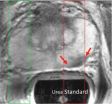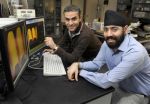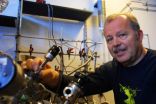(Press-News.org) A UCSF research collaboration with GE Healthcare has produced the first results in humans of a new technology that promises to rapidly assess the presence and aggressiveness of prostate tumors in real time, by imaging the tumor's metabolism.
This is the first time researchers have used this technology to conduct real-time metabolic imaging in human patients and represents a revolutionary approach to assessing the precise outlines of a tumor, its response to treatment and how quickly it is growing.
Data on the first four patients are being presented today at the Radiology Society of North America's weeklong annual conference.
The initial results validate extensive preclinical research that has linked the speed at which tumors metabolize nutrients to the aggressiveness of their growth. The new imaging technique also has been used to show early biochemical changes in animal tumors in real time as they respond to medication therapy, long before a physical change occurs.
So far, the technology has produced the same response in human patients' tumors as it did in laboratory studies, even at the lowest dose, according to Sarah Nelson, PhD, a professor of Radiology and Biomedical Imaging and a member of the California Institute for Quantitative Biosciences (QB3) at UCSF.
"This is a key milestone that could dramatically change clinical treatment for prostate cancer and many other tumors," Nelson said. "We had shown this worked in animal models and tissues samples. Now, in men, we are seeing exactly the type of results we had hoped for."
For an oncologist, that means immediate feedback on whether a patient should continue in "watchful waiting" or pursue treatment, and also whether a therapy is working, either during standard treatment or in a clinical trial.
"If we can see whether a therapy is effective in real time, we may be able to make early changes in that treatment that could have a very real impact on a patient's outcome and quality of life," said Andrea Harzstark, MD, an oncologist with the UCSF Helen Diller Family Comprehensive Cancer Center who is leading the clinical aspects of the current study.
More than 200,000 men are diagnosed with prostate cancer each year and 28,000 die from it, making it one of the most common cancers in men nationwide and also one of the leading causes of cancer death in men, according to the Centers for Disease Control.
Yet the disease ranges widely in its rate of growth and aggressiveness, according to John Kurhanewicz, PhD, a UCSF expert in prostate cancer imaging. As a result, there is great debate over the ideal strategy for treating the disease, he said, leaving patients with a difficult and potentially life-changing decision over how aggressively to respond to the disease.
"This test could give both physicians and patients the information they need to make that decision," said Kurhanewicz, whose work with Dan Vigneron, PhD, and their colleagues from the UCSF Department of Radiology and Biomedical Imaging first linked a prostate tumor's production of lactate to tumor aggressiveness. Other researchers also have linked that lactate production to tumor aggressiveness and response to therapy in other cancers.
The method uses compounds involved in normal tissue function – in this case, pyruvate, which is a naturally occurring by-product of glucose, and lactate, also known as lactic acid – and uses newly developed equipment to increase the visibility of those compounds by a factor of 50,000 in a magnetic resonance imaging (MRI) scanner.
That process requires pyruvate to be prepared in a strong magnetic field at a temperature of minus 272O C, then rapidly warmed to body temperature and transferred to the patient in an MRI scanner before the polarization decays back to its native state.
The result is a highly defined and clear image of the tumor's outline, as well as a graph of the amount of pyruvate in the tumor and the rate at which the tumor converts the pyruvate into lactate.
The sterile production process requires a dedicated clinical pharmacist with the knowledge of both quality control and of clinical practice. As the birthplace of the field of clinical pharmacy and one of only a handful of schools nationwide with drug production expertise, the UCSF School of Pharmacy and contributions of Marcus Ferrone, PharmD, and his colleagues in the Drug Products Services Laboratory were integral to this process.
The procedure must take place within minutes, which meant integrating a clean room into the scanning facility. QB3 also worked with GE Healthcare in designing Byers Hall, in which the Surbeck Laboratory of Advanced Imaging is housed, to accommodate the extremely strong magnetic field of the MRI scanner and enable time-sensitive experiments.
"All of that insight is why we moved this technology to Northern California," said Jonathan Murray, general manager, Metabolic Imaging at GE Healthcare. "This is a huge accomplishment UCSF and QB3 have achieved. They brought together the best engineering from UC Berkeley and the best bioscience and pharmacy knowledge from UCSF, and are now demonstrating the technology in a world-renowned academic medical center. We are delighted with the speed of progress of this collaboration. The science is very exciting."
The first trial involves men with prostate cancer involved in the "watchful waiting" phase of treatment, Nelson said. Future studies will directly compare these data with the results from surgically removed tumors and will look at how specific therapies change tumor metabolism. UCSF also will be studying the process for use in brain tumor patients.
The project's funding through the National Institute of Biomedical Imaging and Bioengineering, in the National Institutes of Health, was critical in adapting this technology for humans and developing new ways to obtain the MR metabolic imaging data. The project received further support from the American Recovery & Reinvestment Act and the UC Discovery Program.
Initial development of this instrumentation and its demonstration of proof of principle was conducted by Jan Henrik Ardenkjaer-Larsen, Klaes Golman and other colleagues from across GE. UCSF customized that principle and obtained the Investigational New Drug (IND) approval from the Food and Drug Administration to use the hyperpolarized pyruvate in humans.
These concepts are still investigational and not being offered for sale, nor have they been cleared or approved by the FDA for commercial availability.
INFORMATION:
About GE Healthcare
GE Healthcare provides transformational medical technologies and services that are shaping a new age of patient care. Our broad expertise in medical imaging and information technologies, medical diagnostics, patient monitoring systems, drug discovery, biopharmaceutical manufacturing technologies, performance improvement and performance solutions services help our customers to deliver better care to more people around the world at a lower cost. In addition, we partner with healthcare leaders, striving to leverage the global policy change necessary to implement a successful shift to sustainable healthcare systems.
Our "healthymagination" vision for the future invites the world to join us on our journey as we continuously develop innovations focused on reducing costs, increasing access and improving quality around the world. Headquartered in the United Kingdom, GE Healthcare is a unit of General Electric Company (NYSE: GE). Worldwide, GE Healthcare employees are committed to serving healthcare professionals and their patients in more than 100 countries. For more information about GE Healthcare, visit our website at www.gehealthcare.com.
About QB3 and UCSF
QB3 is a cooperative effort among private industry and more than 200 scientists at UCSF, UC Berkeley and UC Santa Cruz. One of four California technology institutes, QB3 harnesses the quantitative sciences of information technology, imaging and engineering to integrate and enhance scientific understanding of biological systems, enabling scientists to tackle problems that have been previously unapproachable. Please visit www.qb3.org.
UCSF is a leading university dedicated to promoting health worldwide through advanced biomedical research, graduate-level education in the life sciences and health professions, and excellence in patient care. For more information on UCSF, visit www.ucsf.edu. For specific information on UCSF imaging, visit: www.radiology.ucsf.edu/research.
Follow UCSF on Twitter at http://twitter.com/ucsf
'Watchful waiting' has a new set of eyes
Prostate cancer imaging shows real-time tumor metabolism
2010-12-04
ELSE PRESS RELEASES FROM THIS DATE:
Iowa State, Ames Lab researchers fabricate more efficient polymer solar cells
2010-12-04
AMES, Iowa – Researchers from Iowa State University and the Ames Laboratory have developed a process capable of producing a thin and uniform light-absorbing layer on textured substrates that improves the efficiency of polymer solar cells by increasing light absorption.
"Our technology efficiently utilizes the light trapping scheme," said Sumit Chaudhary, an Iowa State assistant professor of electrical and computer engineering and an associate of the U.S. Department of Energy's Ames Laboratory. "And so solar cell efficiency improved by 20 percent."
Details of the fabrication ...
UCSB scientists report study of 'brain maps' for how humans reach
2010-12-04
(Santa Barbara, Calif.) –– A ballet dancer grasps her partner's hand to connect for a pas de deux. Later that night, in the dark, she reaches for her calf to massage a sore spot. Her brain is using different "maps" to plan for each of these movements, according to a new study at UC Santa Barbara.
In preparing for each of these reaching movements, the same part of the dancer's brain is activated, but it uses a different map to specify the action, according to the research. Planning to hold hands is based on her visual map of space. Her second plan, to reach for her calf, ...
Researchers discover a way to simultaneously desalinate water, produce hydrogen and treat wastewater
2010-12-04
DENVER (December 2, 2010) – Fresh water and reusable energy. Humans are on a constant hunt for a sustainable supply of both. Water purification requires a lot of energy, while utility companies need large amounts of water for energy production. Their goal is to find a low-energy-required treatment technology. Researchers from the University of Colorado Denver College of Engineering and Applied Science may have discovered an answer.
Last year, a study published in Environmental Science & Technology incorporated desalination into microbial fuel cells, a new technology ...
Spanish Oncology to establish a new standard treatment on breast cancer at early stages
2010-12-04
Madrid, 2 december 2010.- Spanish Oncology has established a new standard treatment for Breast Cancer at early stages thanks to the results of the study 9805/Target 0 funded by Spanish Breast Cancer Research Group (GEICAM) and sponsored by Sanofi Aventis.
More than thousand patients and 50 hospitals participated in the study, whose findings are reported in the latest issue of The New England Journal of Medicine. Results indicate that docentaxel during quimotherapy reduces the risk of recurrence by 32% in women with high-risk but node-negative, early stage breast cancer ...
Farmers slowed down by hunter-gatherers: Our ancestors' fight for space
2010-12-04
Agricultural – or Neolithic – economics replaced the Mesolithic social model of hunter-gathering in the Near East about 10,000 years ago. One of the most important socioeconomic changes in human history, this socioeconomic shift, known as the Neolithic transition, spread gradually across Europe until it slowed down when more northern latitudes were reached.
Research published today, Friday, 3 December 2010, in New Journal of Physics (co-owned by the Institute of Physics and the German Physical Society), details a physical model, which can potentially explain how the spreading ...
Decreased physician reimbursement for hormone therapy may reduce over-treatment of prostate cancer
2010-12-04
The use of androgen suppression therapy (AST) in prostate cancer for low-risk cases declined following a decrease in physician reimbursement, according to a study published online TK in The Journal of the National Cancer Institute. However, the indicated use of AST for metastatic disease in the palliative setting did not decline in the same period.
The use of AST in prostate cancer increased more than threefold between 1991 and 1999 both for patients with metastatic cancer and those with low-risk disease, but AST treatment in the latter group has not been shown to improve ...
Assessing positive outcomes of phase III trials
2010-12-04
Randomized phase III studies should be designed to find out whether a new drug or treatment makes a meaningful difference in patients' survival or quality of life, according to a commentary published online December 3rd in The Journal of the National Cancer Institute. Instead, most trials now are designed to detect a statistically significant difference between treatment and control groups, which may not be clinically meaningful, write Alberto Ocana, M.D., Ph.D. and Ian F. Tannock, M.D., Ph.D., of Princess Margaret Hospital in Toronto.
Regulatory agencies such as the ...
Improvement needed for mastectomy outcome reporting
2010-12-04
Improved standards for outcome reporting in breast reconstruction are needed, according to a review published online December 3rd in The Journal of the National Cancer Institute.
Every year in the United States up to 40% of women with breast cancer undergo a mastectomy. They say the most valuable factor in their decision-making is information from health professionals. However, that information is largely dependent on the quality, reporting, and interpretation of research data on surgical procedures.
To summarize the reporting standards of surgical outcomes in breast ...
Breast CT imaging system marches forward as pain-free tool to aid mammograms
2010-12-04
While questions persist about the best ways to detect breast cancer early, a CT imaging system developed at the University of Rochester Medical Center and first unveiled five years ago is in a better position today to enter the fray -- at least in a supporting role to conventional mammography.
URMC radiologist Avice O'Connell, M.D., was invited to summarize the studies conducted thus far on the Cone Beam Computed Tomography (CBCT) scanner, at the Radiological Society of North America Annual Scientific Assembly in Chicago at 8:30 a.m. (EST) on Friday, December 3, 2010.
O'Connell ...
Anesthetic gases heats climate as much as 1 million cars
2010-12-04
When doctors want their patients asleep during surgery they gently turn the gas tap. But Anaesthetic gasses have a global warming potential as high as a refrigerant that is on its way to being banned in the EU. Yet there is no obligation to report anaesthetic gasses along with other greenhouse gasses such as CO2, refrigerants and laughing gas.
One kilo of anaesthetic gas affects the climate as much as 1620 kilos of CO2. That has been shown by a recent study carried out by chemists from University of Copenhagen and NASA in collaboration with anaesthesiologists from the ...
LAST 30 PRESS RELEASES:
Microplastics detected in rural woodland
JULAC and Taylor & Francis sign open access agreement to boost the impact of Hong Kong research
Protecting older male athletes’ heart health
KAIST proposes AI-driven strategy to solve long-standing mystery of gene function
Eye for trouble: Automated counting for chromosome issues under the microscope
The vast majority of US rivers lack any protections from human activities, new research finds
Ultrasound-responsive in situ antigen "nanocatchers" open a new paradigm for personalized tumor immunotherapy
Environmental “superbugs” in our rivers and soils: new one health review warns of growing antimicrobial resistance crisis
Triple threat in greenhouse farming: how heavy metals, microplastics, and antibiotic resistance genes unite to challenge sustainable food production
Earthworms turn manure into a powerful tool against antibiotic resistance
AI turns water into an early warning network for hidden biological pollutants
Hidden hotspots on “green” plastics: biodegradable and conventional plastics shape very different antibiotic resistance risks in river microbiomes
Engineered biochar enzyme system clears toxic phenolic acids and restores pepper seed germination in continuous cropping soils
Retail therapy fail? Online shopping linked to stress, says study
How well-meaning allies can increase stress for marginalized people
Commercially viable biomanufacturing: designer yeast turns sugar into lucrative chemical 3-HP
Control valve discovered in gut’s plumbing system
George Mason University leads phase 2 clinical trial for pill to help maintain weight loss after GLP-1s
Hop to it: research from Shedd Aquarium tracks conch movement to set new conservation guidance
Weight loss drugs and bariatric surgery improve the body’s fat ‘balance:’ study
The Age of Fishes began with mass death
TB harnesses part of immune defense system to cause infection
Important new source of oxidation in the atmosphere found
A tug-of-war explains a decades-old question about how bacteria swim
Strengthened immune defense against cancer
Engineering the development of the pancreas
The Journal of Nuclear Medicine ahead-of-print tip sheet: Jan. 9, 2026
Mount Sinai researchers help create largest immune cell atlas of bone marrow in multiple myeloma patients
Why it is so hard to get started on an unpleasant task: Scientists identify a “motivation brake”
Body composition changes after bariatric surgery or treatment with GLP-1 receptor agonists
[Press-News.org] 'Watchful waiting' has a new set of eyesProstate cancer imaging shows real-time tumor metabolism


